
Agamidae is a family of over 550 species of iguanian lizards indigenous to Africa, Asia, Australia, and a few in Southern Europe. Many species are commonly called dragons or dragon lizards.

Leiosauridae is a family of iguanian lizards containing six genera and 34 species. The family is endemic to Central America and South America.

The Iguanidae is a family of lizards composed of the iguanas, chuckwallas, and their prehistoric relatives, including the widespread green iguana.

The genus Brachylophus consists of four extant iguanid species native to the islands of Fiji and a giant extinct species from Tonga in the South West Pacific. One of the extant species, B. fasciatus, is also present on Tonga, where it has apparently been introduced by humans.

The Galápagos land iguanas comprise the genus Conolophus of the Galápagos Islands (Ecuador). The number of species of this variable genus has always been disputed; the most current taxonomic surveys suggest that three species exist:
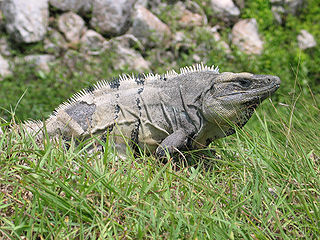
Ctenosaura is a lizard genus commonly known as spinytail iguanas or ctenosaurs. The genus is part of the large lizard family Iguanidae and is native to Mexico and Central America. The name is derived from two Greek words: κτενός, meaning "comb", and σαύρα, meaning "lizard".
The spiny weapontail is a species of lizard belonging to the monotypic genus Hoplocercus in the family Hoplocercidae. The species is found in the Cerrado and adjacent Cerrado–Amazon mosaics in Brazil and Bolivia.
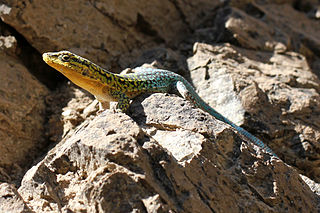
Liolaemus is a genus of iguanian lizards, containing many species, all of which are endemic to South America.

George Albert Boulenger was a Belgian-British zoologist who described and gave scientific names to over 2,000 new animal species, chiefly fish, reptiles, and amphibians. Boulenger was also an active botanist during the last 30 years of his life, especially in the study of roses.
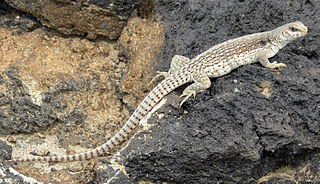
The desert iguana is an iguana species found in the Sonoran and Mojave Deserts of the Southwestern United States and northwestern Mexico, as well as on several Gulf of California islands.
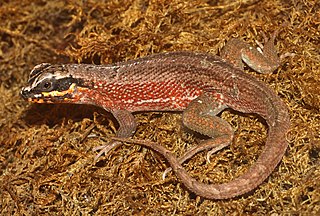
Iguania is an infraorder of squamate reptiles that includes iguanas, chameleons, agamids, and New World lizards like anoles and phrynosomatids. Using morphological features as a guide to evolutionary relationships, the Iguania are believed to form the sister group to the remainder of the Squamata, which comprise nearly 11,000 named species, roughly 2000 of which are iguanians. However, molecular information has placed Iguania well within the Squamata as sister taxa to the Anguimorpha and closely related to snakes. The order has been under debate and revisions after being classified by Charles Lewis Camp in 1923 due to difficulties finding adequate synapomorphic morphological characteristics. Most iguanians are arboreal but there are several terrestrial groups. They usually have primitive fleshy, non-prehensile tongues, although the tongue is highly modified in chameleons. Today they are scattered occurring in Madagascar, the Fiji and Friendly Islands and Western Hemisphere.
Wiegmann's tree lizard is a species of lizard in the family Leiosauridae. The species is endemic to South America.
Proctoporus xestus, or the river teiid, is a species of lizard in the family Gymnophthalmidae. The species is endemic to South America.

Enyalioides laticeps, the Amazon broad-headed wood lizard, is a dwarf iguanian lizard abundantly found in Amazonian rainforests. They are semi-arboreal and mostly live in forests. Other names for it include broad-headed wood lizards, Big-headed stick lizards, Guichenot's Dwarf Iguana, Amazon Forest Dragon, or Amazon Dwarf-Iguana. It is a small, ornamented lizard that grows up to 157 mm (0.5 ft) long and have very high vertebral crests along their backs. They change colors based on environmental factors. Amazon broad-headed wood lizards rely on rapid running to move around; however, they spend the vast majority of their time motionless, blending into the rainforest background, and ambushing prey. When attacked by predators, E. laticeps may stay motionless like a wood stick to avoid predation. When found by predators, it may suddenly spring into motion, quickly reatreting to burrows in the ground.

Acrodonta are a subclade of iguanian squamates consisting almost entirely of Old World taxa. Extant representation include the families Chamaeleonidae (chameleons) and Agamidae, with at least over 500 species described. A fossil genus, Gueragama, was found in Brazil, making it the only known American representative of the group.
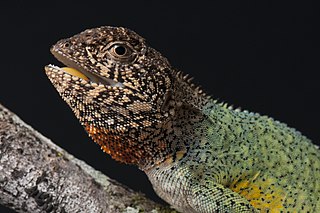
Enyalius is a genus of lizards in the family Leiosauridae. The genus is native to Brazil and Uruguay.

Enyalioides cofanorum, also known commonly as the Cofan woodlizard, Duellman's dwarf iguana, and lagartija de palo cofanes in Spanish, is a species of lizard in the family Hoplocercidae. The species is native to northwestern South America.
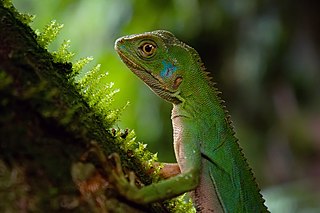
Enyalius iheringii, also known commonly as Ihering's fathead anole, is a species of lizard in the family Leiosauridae. The species is endemic to Brazil.
Urostrophus gallardoi is a species of lizard in the family Leiosauridae. The species is native to South America.
Stenocercus festae, also known commonly as Peracca's whorltail iguana and Peracca's whorl-tailed iguana, is a species of lizard in the family Tropiduridae. The species is endemic to Ecuador.














